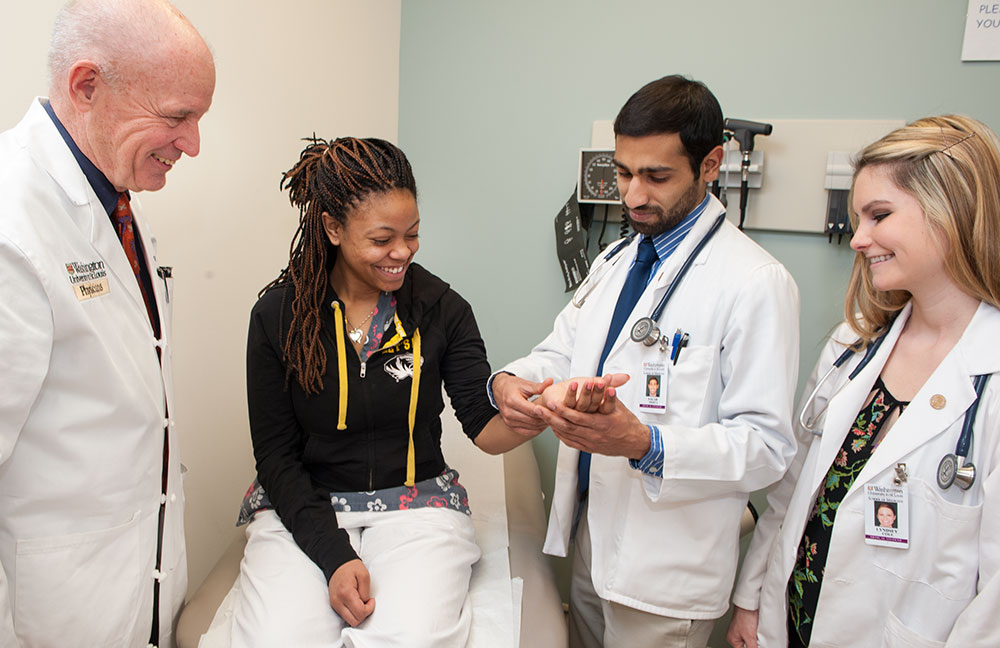
Our students and faculty pride themselves on their shared pursuit of clinical excellence and revel in the joy and privilege of clinical interactions with the people for whom they care.
Clinical learning brings together and emphasizes:
- The scientific underpinnings of medicine
- Cultural competence and appreciation of diversity
- Effective two-way communication
- Teamwork and collaboration
- Preventive care and health maintenance
- Compassionate caring and health care delivery
Early bedside clinical learning
Clinical training emphasizes both the science of medicine and the art of effective communication with patients. Under the watchful eyes of seasoned clinicians, medical students begin learning to take histories and to examine patients soon after starting medical school.
- Extensive resources for honing clinical skills
- Simulation center
- Standardized patients
- Videotaping and feedback of patient encounters
The Gateway Curriculum provides three Clinical Immersions in Phase 1 of the student experience–one each in the outpatient, inpatient, and procedural environments. Each immersion is three weeks in length.
Washington University School of Medicine provides an environment where exceptional clinical training occurs. We have one of the nation’s largest academic medical centers. Our on-site hospital affiliates provide 1,893 licensed beds; two of those affiliates, Barnes-Jewish Hospital and St. Louis Children’s Hospital, are members of BJC HealthCare, the first integrated health-care system in the country. These large and highly rated hospitals provide outstanding training opportunities, with a large volume of primary through quaternary care patients. Students play an integral role in hands-on patient care, working in small groups with master clinicians, residents and fellows. World-renowned resources that help learners become their best selves include:
- Extraordinary clinical facilities
- Large and diverse patient population
- Superlative clinical teachers. Faculty often perform dual roles as scientists and clinicians, bringing the most current knowledge and methods of inquiry from the laboratory to the bedside and supporting translational, clinical, and community-based research.
Diverse Patient Population
As a Washington University medical student, you will learn medicine at the bedside of one of the largest and most diverse patient populations in the country. You will come face to face with the full spectrum of medical issues, from the ordinary to the most rare and complex. Barnes-Jewish Hospital, our main teaching hospital, acts as a safety net for the citizens of St. Louis–serving the uninsured and underinsured. You will witness firsthand the social and structural determinants of health. Despite the size of the medical campus, clinical education occurs largely at patients’ bedsides and in one-on-one or small group settings. It’s the best of all circumstances: a broad base of patients and an intimate mentoring environment.
In addition to Barnes-Jewish and St. Louis Children’s Hospitals, students also rotate though other hospitals in the community including Missouri Baptist Medical Center, the Veterans Administration Medical Center, and Progress West. Other clinical settings include the Federally Qualified Health Centers (FQHCs) Care STL and Affinia, in addition to sites in rural Missouri with primary care preceptors. A substantial percentage of students do rotations at other institutions, both inside and outside the United States.
Clinical Volume Statistics
- 77 specialties and subspecialties
- 1,888 clinical faculty
- 12,000 newly diagnosed cancer patients are seen annually at the Alvin J. Siteman Cancer Center at Barnes-Jewish Hospital and Washington University School of Medicine
- 103,604 hospital discharges (BJH/SLCH, 2022)
- 275,000 patient visits annually at St. Louis Children’s Hospital
- 1,535,438 outpatient visits by Washington University physicians (2022)
Patient Facts
- From nine surrounding states and beyond — urban, suburban and rural
- A full range of ages and ethnic and socioeconomic groups
- Culturally diverse city and region